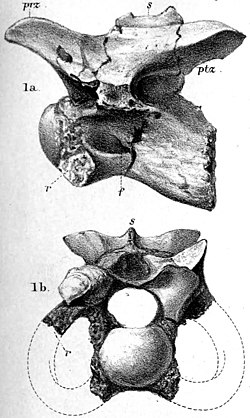Calamosaurus
|
Calamosaurus Temporal range: Early Cretaceous, Barremian |
|
|---|---|
 |
|
| Cervical vertebra of Calamosaurus foxi | |
| Scientific classification | |
| Kingdom: | Animalia |
| Phylum: | Chordata |
| Class: | Reptilia |
| Clade: | Dinosauria |
| Order: | Saurischia |
| Suborder: | Theropoda |
| Family: | †Compsognathidae |
| Genus: |
†Calamosaurus Lydekker, 1891 |
| Species: | †C. foxi |
| Binomial name | |
|
Calamosaurus foxi (Lydekker, 1889 [originally Calamospondylus]) |
|
Calamosaurus (meaning "reed lizard") was a genus of small theropod dinosaur from the Barremian-age Lower Cretaceous Wessex Formation of the Isle of Wight, England. It is based on two cervical vertebrae (BMNH R901), collected by Reverend William Fox.
Richard Lydekker ran across these bones when cataloguing the Fox collection and named them Calamospondylus, noting their similarity to those of Coelurus. Unfortunately, Calamospondylus had already been coined in 1866 (ironically by Reverend Fox himself, the very man honored in Lydekker's species name). Lydekker renamed it in 1891 to its present title. He also at this time provisionally referred to it a tibia, BMNH R186, which may be from a basal coelurosaurian like a compsognathid.
Because of its sparse remains, it has received little attention. Often, it has been synonymized with Calamospondylus as part of a long, confusing taxonomic tangle, although there is no comparable material between the two genera. Modern reviews have regarded it as a dubious theropod, although potentially a valid coelurosaurian.
In 2002 Paul Turner found a dorsal vertebra near Grange Chine on the Isle of Wight. An associated partial tibia and metatarsal fragment were subsequently discovered by Oliver Mattsson and referred to Calamosaurus. Naish (2011). Another specimen referred to Calamosaurus was collected by local fossil hunter Kai Bailey in 2014. Both specimens are on display at the Dinosaur Expeditions, Conservation and Palaeoart Centre near Brighstone, Isle of Wight.
...
Wikipedia
